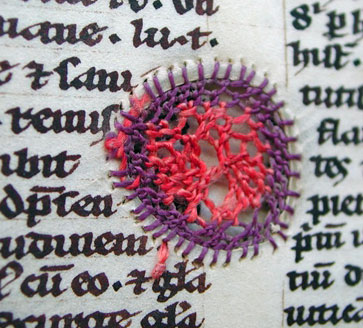Book art – the manipulation, recycling, up-cycling, embellishing, cutting, folding, sculpting, stitching, or myriad-other-things done to books (especially to old books) in the quest of creativity – is pretty popular today.
While some of the things paper artists do with old books are amazing, enchanting, and incredibly artistic – like these book-cut sculptures by Sue Blackwell – most of the creative approaches that require the destruction of a book don’t thrill me all that much. I chalk it up to years of teaching literature and an almost fanatical fondness for books as books.
So although stitching on pages of books is not something I’d normally consider enticing, there are definitely exceptions. This particular exception is fascinating – especially because it is a work of restoration.
Stitching on the pages of a book is apparently not a new thing.

At the Uppsala (Sweden) University Library webpage, you can find an article about a medieval manuscript (14th century) that was repaired with colored silks and embroidery stitches, specifically buttonhole stitch.

If you haven’t read the article yet or seen images of the book with its parchment pages repaired with embroidery, do go look and have a read!
There’s some interesting information in the article about the way the book was repaired and how the manuscript has been recently restored to avoid further deterioration of the black silk thread, which has rotted away. Most interesting to me was the discussion of why the black silk didn’t stand the test of time although the other colors – many quite vibrant – did.
It’s not a long article, but it’s an interesting article. Definitely worth visiting the Uppsala University website to read, especially for those interested in medieval art, manuscripts, historical embroidery, silk, thread dyeing techniques, and the like.
Enjoy!







Thank you Mary, this is amazing. Saturday posts always feel like a treat, probably because I can take my time reading them, but this one is fabulous!!!!!
That is utterly fascinating! Makes me want to go out and mend some books – no really! I may do that anyway on some of my own books along the margins. Question: Would it have been safer to use linen floss or are all the black dyes the same? I want to use strictly black and cream and gold. Does the paper age make a difference?
Thanks for this posting.
What a fascinating story. Of course, when you think about it, there’s no reason not to use silk to repair parchment, but there’s something quite charming in the picture of the nuns sitting there making delicate needle-lace fillings in coloured silk to beautify their precious pages as well as to strengthen them. I’m sure this post will inspire some of the modern makers of fabric books to do interesting things with cuts and holes.
Black dyes and inks were often destructive. Old samplers are often missing the black threads. The pretty colours may fade away, but they do far less damage in the process. (In oil paint, it was ‘mummy brown’ – yes, made with real Egyptian mummies! – that caused damage to eighteenth century masterpieces, due to the presence of bitumen.)
Thanks for sharing this discovery, Mary.
Dear Mary
Sue Blackwell site is intriguing I’ve never heard of book art before they are similar to the children’s pop up books that I used to read as a child. preservation through needlework in books is interesting, again I’ve not come across this before. I always find something new on your site Mary so thanks for sharing this with us very interesting.
Regards Anita Simmance
Both links are really facinating! Thanks for sharing Mary.
What an interesting book! I have an interest in restoration, but I never would have thought of that method of repair. Fascinating!
Thanks for sharing,
Susan in Texas
This was very interesting. I’m thinking the same issues with the tannis and acids cause black fabrics to deteriorate out of antique quilts as well. Of course I don’t have any that are that old, but the principle would still hold true. It makes sense to me that the nuns would have used their silk threads to mend these books. Books were a luxury and valued treasure before the printing press. Silk would be fine enough not to tear the paper and add some beautiful color, whereas cotton and wool would be heavier and linen would have been considered a standard thread, but not have the color choices or value as the silks.
Aloha Mary,
Utterly fascinating ! I would never have guessed that old books were repaired like this. What an eye opener. Books are one man made item that have been and will be precious to people.
As the mother of three young adults who are all computer saavy (sp) but refuse to acknowledge the Kindle I can see them appreciating this repair of an old book.
ji
Wow, that’s amazing! First I thought it was a modern textile/book art piece, but, no, it’s a medieval manuscript.
It was on display 9 May 2003 – 8 April 2004 — a time when I lived but a short train ride south of Uppsala! I could’ve had a chance to see it IRL… But I didn’t know about the exhibit then and even if I had I wasn’t into embroidery in those days.
If you’re interested in historical embroidery (though often less interesting than this), you might want to check out kringla.nu, a website where you can search the collections and archives of many of the swedish museums. Some items are swedish, others foreign, some are almost news others prehistoric. All in swedish though… A direct link to hits when searching for embroidery (broderi): http://www.kringla.nu/kringla/sok?text=broderi&filter=thumbnailExists%3Dj&filter=itemType%3Dobjekt/f%C3%B6rem%C3%A5l
By the way, I don’t like “book murder” (to use a term from Jonathan Strange & Mr Norrell if I remember correctly) either, but I can’t help but love Guy Laramée’s book carvings. Some are pretty magical, like the one at the top here: http://www.thisiscolossal.com/2012/06/new-carved-book-landscapes-by-guy-laramee/
(Colossal, by the way, is a blog I subscribe to for a daily dose of cool eye-candy art of all kinds. Sometimes even embroidery.)
Oh my!!! I absolutely love this…I can see why they did the conservation with the silk gauze(as it’s the current museum standard best practice and all in preservation), but there’s a part of me that wants them to actually repair the work with new black thread so we could see it as it’s supposed to look…What a brilliant concept though…an embroidered repair!
I also have a huge problem with people tearing up books for the sake of “art?” I have a large collection of vintage and antique books. I like to go to Half Price Books just to look in their nostalgia section. I have picked up some of the best novels I have ever read from the 20’s through the 40’s.
Now the art in the above book was preservation done beautifully. I can understand that.
I have had thoughts of making ‘altered book’ art but when it comes to it, I can’t bear to destroy a book either, even though it is in Russian and I have no hope of reading it.
The embroidered repairs on the other hand are absolutely amazing. Black dyes are still troublesome – some black silk threads I have in my collection feel totally different in texture to other colours. And have you noticed how quickly black clothing becomes grey when laundered? My Mama was given this tip some years ago, and since then my blacks have stayed black for much longer. You simply wash and hang to dry inside out. Other tips are to put some coffee in with the final rinse. Sorry Mary, that is so Off Topic.
It is a terrible shame that the vellum was damaged in the first place. I believe they said it was done during its transformation from goat skin to vellum, so presumably the text was written around the ‘holes’ so none of it is lost. The embroidery is gorgeous, all those lovely colours. Thanks Mary, you are a mine of wonderful information.
Thanks for the lovely post. The repairs are book art I can genuinely appreciate (unlike anything that involves cutting up or otherwise destroying books, which tends to make me cringe).
Dear Mary, the Mission Rose is an amazing piece of embroidery and has shown a great deal of thought and maybe bravery in your choices. I do feel that the stems would have been better in the restrained two colour design since the multi shaded stems run the risk of dominating the image rather than the rose itself. You have said that the camera doesn’t catch the colour of the blue silk. I would have liked to have seen a more subtle gold or pale green (green being one of the five liturgical colours. But that is personal taste. Well down Mary, I have so enjoyed your turorialks.
Thank you
Michael